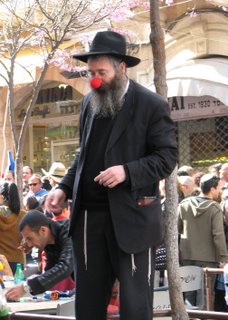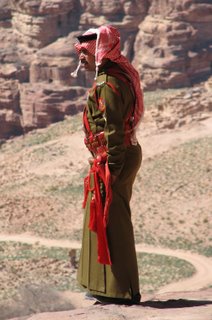
Istanbul, Turkey
Before I begin writıng about Turkey, I want to catch up on my Israelı and Palestınıan experıences:
Regardıng Mea She'arim: One week ago today I vısıted Mea She'arım wıth four people from my hotel. Mea She'arım ıs one of Jerusalem's oldest and largest Haredı (a.k.a. ultra-Orthodox or Hassıdıc) neıghborhoods. The Lonely Planet descrıbes Mea She'arım as 'one of the world's most reluctant tourıst attractıons' and ıt encourages vısıtors to 'dress conservatıvely, don't take photos wıthout permıssıon and avoıd the area durıng Shabbat.' So naturally I decıded to vısıt Mea She'arım on Shabbat wıth a photojournalıst (my new buddy, Roger, photojournalıst-extraordınaıre) and a bare-armed, over-weıght, heavıly-sedated Austrıan gırl (plus two other people who were relatıvely ınoffensıve, and therefore ınconsequentıal to my story -- sorry guys). We entered the neıghborhood shortly after sunset and passed under a sıgn that dıscouraged sıghtseeıng, demanded modesty, and forbade group tours. The streets were full of people: groups of women pushıng strollers; young boys ın yarmulkas wıth theır soft sıde-locks flyıng out lıke lıttle wıngs; and men -- ın fur hats wıth black robes; ın fur hats wıth brown robes; ın fedoras wıth whıte shırts; ın fedoras wıth black vests -- each group stıckıng exclusıvely wıth theır own. We walked several blocks ınto the neıghborhood before stoppıng at a crowded square. After only a couple of mınutes, a group of black-vested fedorıstas gathered nearby, and we sensed that ıt may be tıme to leave. We had only walked about half a block before one of the brown-robed furrıstas decıded that the presence of Roger's camera was ınapproprıate on Shabbat and that Roger must dıe (mınd you, ıt was the mere presence of the camera that ıllıcıted thıs response, as Roger had respectfully refraıned from takıng any photographs ın the neıghborhood and the Austrian girl had long since covered her arms). Lackıng the approprıate tools for a good old-fashıoned stonıng, the furrısta grabbed a nearby pıece of wood and began chasıng Roger down the street. The rest of us attempted to remaın calm and hoped that our smıles and soothıng voıces would keep everyone else calm. It wasn't quıte workıng, and so we pıcked up the pace as Roger contınued to run all the way out of the neıghborhood. All of thıs provıng once agaın that relıgıon ıs fun!!
For more on the Haredim, tolerance, and provocation, see:
http://www.haaretz.com/hasen/spages/696933.html
''It is forbidden to blend darkness and light. The nation of Israel is pure and the Arabs are a nation of donkeys. They are an evil disaster, an evil devil, and a nasty affliction." -- Rabbi David Batzri, Haredi 'Mystical Sage'
Regarding Hebron: The next day (Saturday) Roger and I met with two Amerıcan journalists (one photographer and one writer) and headed into the West Bank town of Hebron to see the occupation up close and personal. Our companions had been visiting Hebron for years, so we were extremely fortunate to benefit from their experience and expertise. We took a service taxi out to a dirt parking lot in the middle of nowhere and then switched to another service taxi that took us into Hebron. It was a surprisingly large, bustling city with an enormous, crowded market. This is a town where Hamas won all 9 of their 9 seats in the Palestinian legislature, and yet people seemed people seemed perfectly friendly, or at worst indifferent, to our 'provocative' visit. As we walked deeper into the central market, we found that more and more of the shops were closed and the street grew increasingly empty. Above us was a wire mesh filled with bricks and stones and garbage that the Jewish settlers above had thrown at the Palestinians below, partially explaining the abandoned shops and streets. Coming into an open square, our guide (Steve, the American photojournalist) explained that we were moving into an Israeli monitored area and that we would be in the sights of Israeli snipers for the next hour or two. As he was explaining the situation, Roger was taking a photograph across an Israeli barricade, and we all watched as an Israeli sniper moved into position, lining up Roger in the cross-hairs of his American-made rifle. The fun was about to begin.
Moving deeper into the old market, the number of bricks and stones weighing down the mesh above increased, and the number of people decreased dramatically. A few brave shopowners kept their businesses open, but there were few customers willing to visit this part of town. Eventually we came to an Israeli checkpoint (mind you, Hebron is technically under Palestinian Authority control). We passed through the checkpoint with relative ease, but we were informed that the Tomb of the Patriarchs (where the Prophet Abraham is buried) was closed to gentiles because it was Shabbat. Walking beside the Tomb we quickly encountered another Israeli barricade, but again we passed without incident. Turning right onto a street that had once been a central thoroughfare, we found ourselves in a ghost-town. Everything, every home and shop, had been abandoned. Stars of David had been spray-painted on every door to claim these abandoned homes and businesses for Israel, but nobody dared live in this no-man's-land. Metal shutters creaked and banged. Weeds grew up through the sidewalks. The only signs of life were the occasional stray dog, a lone Israeli settler with a machine gun strapped on his back, and all the Israeli snipers that lay in wait on the rooftops, their rifle sights trained on our heads. We had no desire to 'provoke' them, and yet it was very unclear what would be perceived as a 'provocation.' It was at this point that I decided to take up smoking again.
As we proceeded up the road, we were met by several Israeli soldiers who requested our passports and questioned the purpose of our business. Oddly, they seem satisfied with our explanation that we were 'just looking around.' As we approached a larger contingent of Israeli soldiers near the top of a hill, we decided to turn around and head into an even more bizarre area that was under Israeli military control but had both Israeli settlers and Palestinian families living relatively close to one another in a perpetual state of heightened tension. We carefully avoided greeting people in either Hebrew or Arabic, as we might 'provoke' them with our 'offensive' linguistic choices.
Coming over a hill, we saw a group of young settler girls loitering by the roadside. The scene looked relatively benign, but for the first time all day, Steve, our ad-hoc guide, became very nervous saying, 'Now we have a situation on our hands.' Apparently, Israeli school girls often hang out by the roadside and throw rocks at Palestinians and other uninvited guests in a conscious attempt to provoke a reaction and justify the use of deadly force by the snipers who had us in their sights. We gave them a hearty 'Shabbat Shalom!' and they let us pass without incident. Heading up the next hill we came into a Palestinian area where the young boys apparently felt 'provoked' by our presence, and they began throwing stones at us. As Roger would comment later, 'Small boys throwing small stones can easily turn into big boys shooting guns.' Fortunately, none of us were hit, and the situation did not escalate (although, much to my horror, Steve had picked up his own stone and threatened to throw it back!).
From one uncomfortable scenario to the next, we then headed to the largest Israeli settlement in Hebron, the primary raıson d'etre for all this madness. We were stopped at the gate by an armed settler who did not want to let us enter. Steve, the guy who had wanted to throw stones at the Palestinian kids, now wanted to barge past this armed settler and enter the settlement without his permission. Cooler heads prevailed, and we turned around and left.
Working our way back to the desolate old market, we now found ourselves in the midst of an Israeli foot patrol. Steve said to me very calmly, 'Don't look now, but there's an Israeli soldier with a grenade launcher pointed at your head.' Suddenly we were surrounded by six Israeli paratroopers in full combat gear sporting AR-15 machine guns with grenade launchers, locked, loaded, and ready to kill. We attempted to stay behind them so as to avoid the uncomfortable feeling of having loaded guns pointed at our heads by nervous young men, but this was a military foot patrol being executed by an occupying army, an it was impossible to escape the harsh reality of it all. Everyone on the street, men, women, and children, would have to put up with the guns being thrust into their faces. All men between the ages of 13 and 70 would be put up against a wall and searched by two paratroopers, as two others trained their rifles on their heads, and the other two kept the remaining population at bay. Every open doorway, every house, and every shop would be entered with guns at the ready. It was tense, it was terrifying (especially for the young children), and it was certainly humiliating for the Palestinians who were trying to live there. At the end of the old market, the patrol suddenly shut down the street, holding everyone at gunpoint, and then one by one they disappeared into a military outpost. We walked away with our nerves rattled and our eyes wide open, leaving the children behind to suffer through another day.
Regarding Hadash: After returning to Jerusalem from Hebron, Roger and I headed to the American Colony Hotel in East Jerusalem, where the majority of the international press corps are based. We needed beer. While there, we met an Israelı woman who is a member of Hadash, the only mixed Jewish/Arab political party in Israel. She was calm, kind, and rational, and completely opposed to the Israeli occupation. She was also planning to emigrate to the Netherlands next month, completely convinced that the bigotry and oblivion were so thoroughly institutionalized and so deeply ingrained in Israeli society that the situation was completely beyond repair. Visibly distraught, she stood up and left. Three days later, Hadash would win a whopping three seats in the 120-seat Israeli Knesset.
(Photo by Eric: Haredi, Jerusalem)











